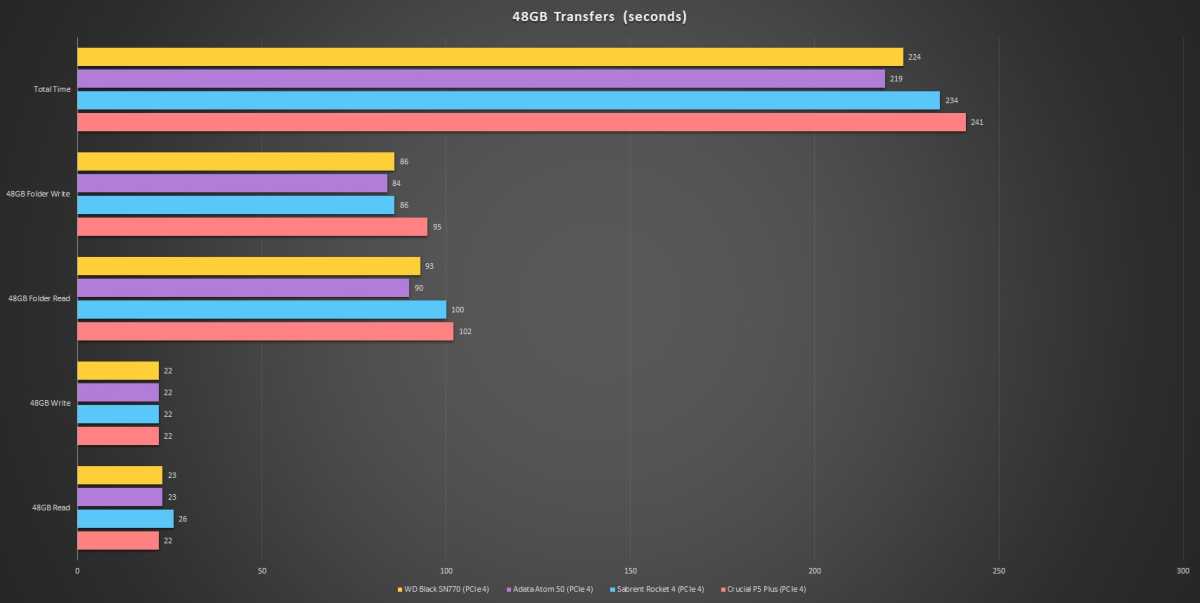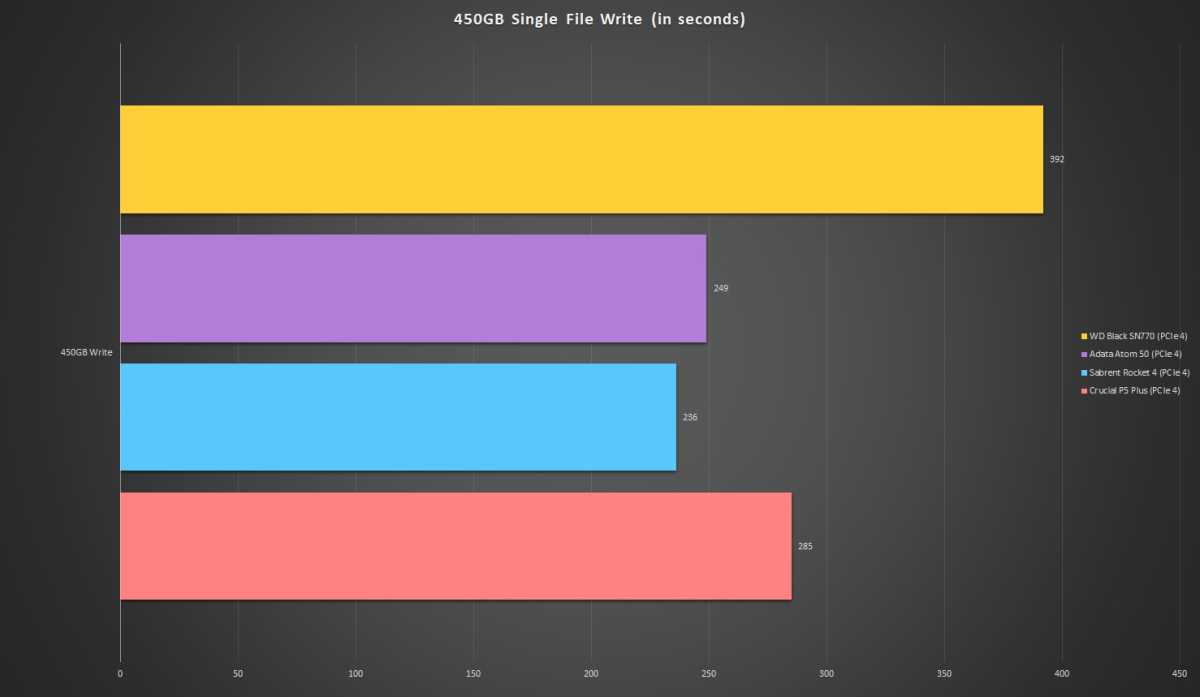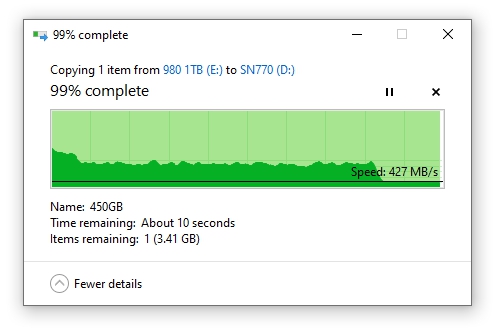WD Black SN770 SSD review: Fast, affordable, and unusual

 Image: WD
Image: WDAt a glance
Expert’s Rating
Pros
AffordableVery good everyday performance
Cons
Slows down to 400MBps on very long writesUses HMB, which is not supported by the PS5 gaming console
Our Verdict
The WD Black SN770 NVMe SSD is a solid, affordable mid-tier PCIe 4 drive that offers further evidence that DRAM-less design has come of age.
Price When Reviewed
250GB/$59, 500GB/$79, 1TB/$129, 2TB/$269
WD’s new Black SN770 is a PCIe 4.0 NVMe SSD that competes nicely with similar mid-tier products in both price and performance. It’s also further proof that DRAM-less SSD design can be very effective in systems that support it. It won’t win any races against some of the luxuriously priced hot rod-type SSDs out there, but the WD Black SN770 is fast and affordable. You’ll have no complaints if you slap one into your PC.
This review is part of our ongoing roundup of the best SSDs. Go there for information on competing products and how we tested them.
Design and features
DRAM-less design means that the SN770 uses host memory buffer (HMB), i.e. your computer’s memory as primary cache. The controller is a proprietary WD/Sandisk design and the NAND is 112-layer TLC according to the company. Note that the image below pictures the included heat spreader; our test unit arrived with chips exposed.

While host memory buffer, which was added to NVMe as of version 1.2, didn’t perform very well on the first such drives we tested, it seems to have come of age with the WD Black SN770 and the recently tested Adata Atom 50. Seemingly, it took the controller folks a while to come to grips with practical implementation.
Note that the Sony Playstation 5 does not support HMB. If you’re thinking of the SN770 (or Atom 50) for use in that console, expect lesser performance, though the secondary caching (TLC used as SLC for faster writes) should allow it to perform adequately.
The SN770 is available in 250GB/$59, 500GB/$79, 1TB/$129 (tested), and 2TB/$269 flavors. The drives are warrantied for 5-years or 200TBW, 300TBW, 600TBW, and 1200TBW (TeraBytes Written over the life of the drive) respectively–about average given the price. Yes, you get a bit more TBW per GB with the 250GB version.
According to WD’s reviewer’s guide specs, the 500GB version will be slightly slower, and the 250GB version will offer about half the write speed and 75% of the read speed. That’s still very fast, though if you can afford the 1TB or 2TB models, we recommend those for the best overall experience.
Performance
WD talks up the SN770 being “faster” in its advertising literature, but that’s largely in comparison to older SSDs using the slower PCIe 3.0 bus. Over PCIe 4, while it’s an all-around good performer (especially in real world transfers), it’s hardly the fastest drive to enter our test facility.
CrystalDiskMark 6, shown below, rated the WD Black SN770 as faster than the similar Adata Atom 50 in sustained throughput, though not by much.

As you can see below, the SN770 was a bit slower in our 48GB transfer tests than the Atom 50, but it still racked up a fifth place finish among the thirty some odd drives we’ve tested. As both the Atom 50 and the SN770 are HMB drives, it’s fair to assume that using system memory is having a net positive effect on small file performance—at least over the faster PCIe 4 bus.

The WD Black SN770 really fell off the pace in our single large 450GB file write–a sure sign that it ran out of secondary TLC-as-SLC cache.

Below is the screen capture of the 1TB SN770 running out of secondary cache at around the 375GB mark. This is hardly unusual, and few users will ever write that large a file, though top-tier drives will handle it better.

The 2TB SN770 wouldn’t suffer a slowdown in this test, while the 250GB and 500GB models will run out of secondary cache far sooner. And yes, the 250GB drive is too small for this test.
The SN770 ran relatively cool in our tests and is a good everyday performer, if not quite as good as the competing Adata Atom 50. Subjectively, you will never notice the difference.
PCIe 4 testing is done on an MSI MEG X570 motherboard socketing an AMD Ryzen 7 3700X 8-core CPU, using 64GB of Kingston 2666MHz DDR4 memory, and an AMD Radeon RX 480 graphics card. ImDisk facilitates the 58GB RAM disk used for the 48GB transfer tests. All testing is performed on an empty, or nearly empty drive that’s TRIM’d after every set of tests. Performance of any SSD will decrease as you fill it up.
Write performance will decrease as the drive fills up. Also, in rare cases, components may change for the worse. WD would not promise that the SN770’s components would not change over time, however, our experience with the company would indicate that performance will remain equal even if they do. Our standard warning with all drives is that, if, given similar hardware, they do not perform as well as our test unit, let us know.
A solid bargain
Though WD has sexy-ed it up in its advertising, the Black SN770 is merely an average PCIe 4 NVMe SSD in terms of performance. However, “merely average” among PCIe 4 NVMe SSDs is very, very fast in practical terms, and WD priced this drive to move–you’ll have no complaints if you buy one for your PC. That said, consider an SSD with a traditional DRAM design if you’re looking to upgrade a PlayStation 5’s storage.
Author: Jon L. Jacobi, Freelance contributor

Jon Jacobi is a musician, former x86/6800 programmer, and long-time computer enthusiast. He writes reviews on TVs, SSDs, dash cams, remote access software, Bluetooth speakers, and sundry other consumer-tech hardware and software.
Recent stories by Jon L. Jacobi:
SanDisk Desk Drive USB SSD review: High capacity, 10Gbps performanceSK Hynix Tube T31 review: Looks like a USB drive, performs like a SSDTeamgroup Z540 review: A worthy competitor for the SSD performance crown



